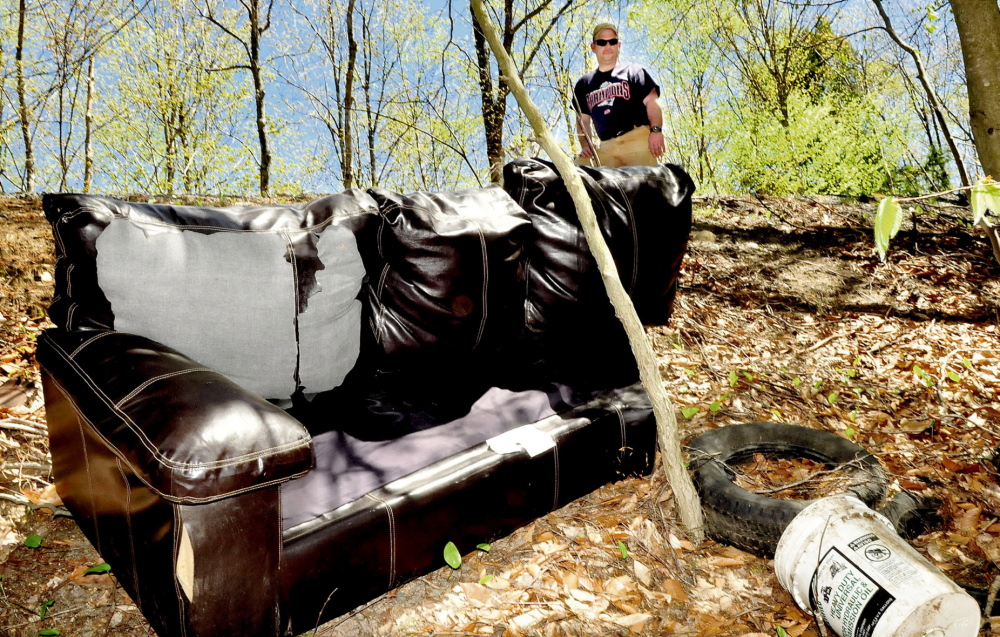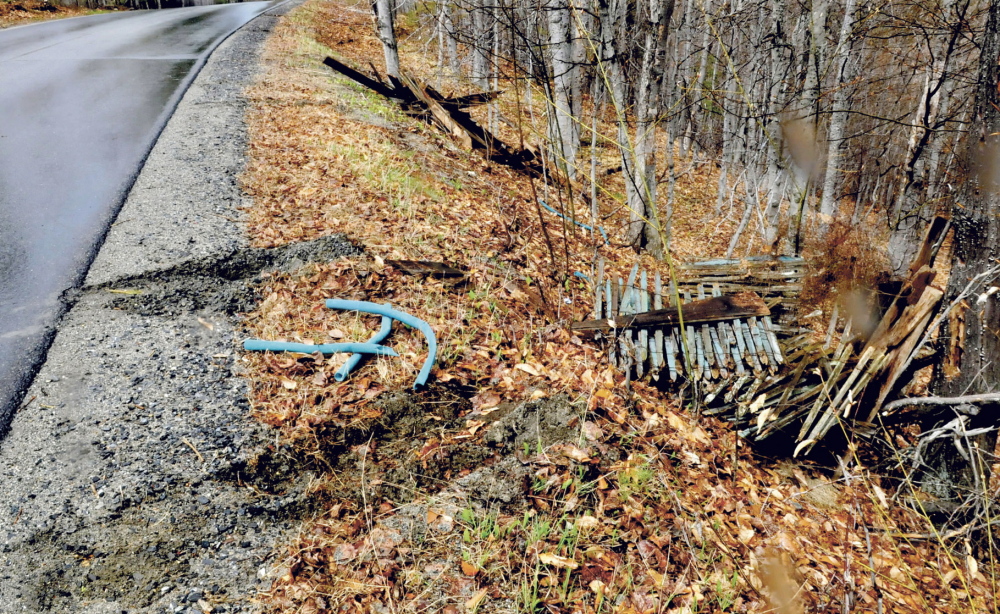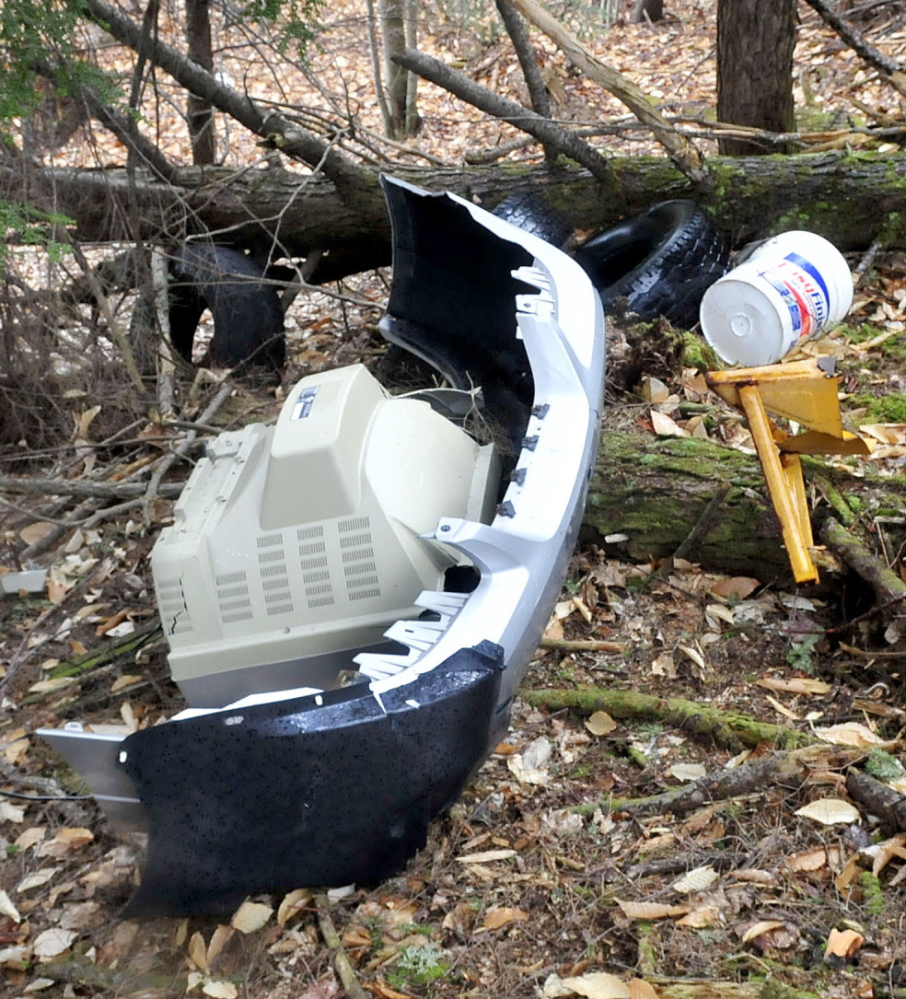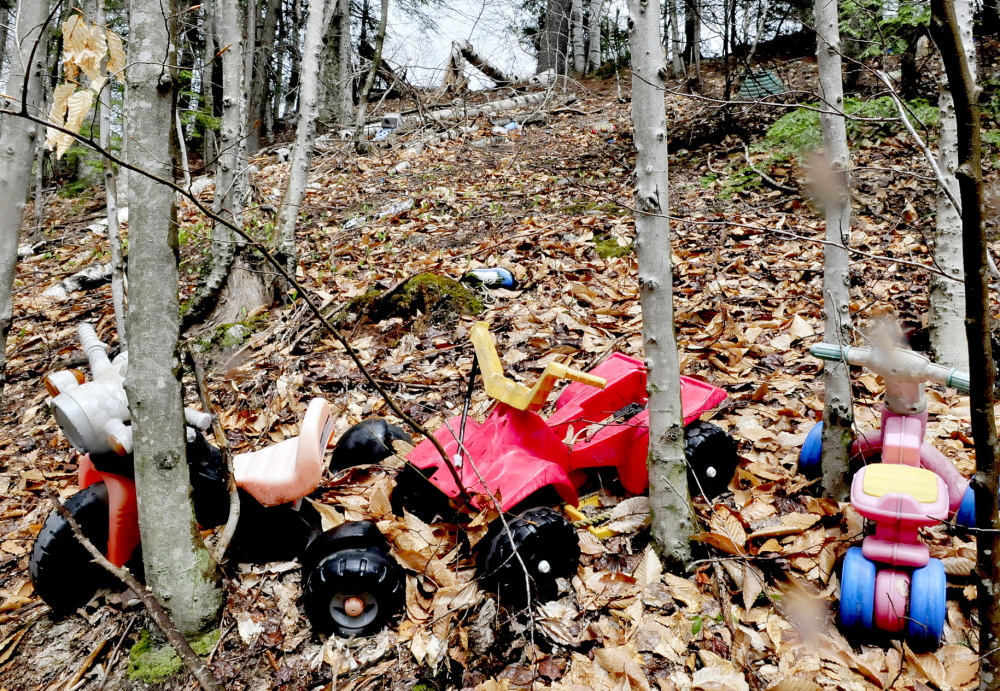To a veteran forest ranger, the excuses used by people caught dumping household trash along Maine’s countryside are all too familiar.
“I saw other trash there, so I thought it was OK,” some say.
Others explain that they had to move out of their residence, and they had no time to go to the landfill or transfer station when it was open.
Using lightly traveled country roads as a dump for unwanted household effects that can’t be tossed into the rubbish barrel isn’t exactly new, but Ranger Matt Gomes, of the Maine Forest Service, said he’s getting more complaints about it.
“Every town has a back road where people think it’s OK,” he said. “Maybe it’s a gravel road (and they think), âNo one’s here. I’ll throw out my old dishwasher and old tires.'”
When someone dumps trash in the woods or alongside a road, it creates costs for land conservation groups, snowmobile and all-terrain vehicle clubs, and state and local public works and forestry agencies.
Much of the responsibility for protecting Maine’s wilderness, though, falls on a shrinking cadre of forest rangers.
When fully staffed, the rangers include just 54 uniformed officers. It now has a dozen vacancies because of a hiring freeze.
“We’re too few and far between,” Gomes said. “Every ranger has to cover about two dozen towns.”
Given the place of trash-dumping on the scale of crimes, most of the enforcement burden falls to the rangers.
“It tends to follow us because we tend to be the law enforcement that’s off the paved roads,” said “We tend to be down the logging roads, the tote roads.”
One of the worst areas for recurring complaints, he said, is Augusta — the state capital.
“It’s a bunch of gravel roads on the western side of the city,” he said. “We’re forever going in there and picking up trash. It continues and continues.”
Gomes said that when he became a ranger 20 years ago, only two or three out of 100 complaints had to do with illegal dumping.
By 2009, 9.5 percent of the complaints the rangers handled were of illegal dumping. It’s gone up every year since, to a new high of about 13 percent of all calls last year.
Enforcement isn’t easy, and it isn’t cheap.
“We put on surgical gloves and we start digging through everything,” he said. “Then we approach those people and say: âWe found your trash. What’s up?'”
In 2012, as part of Landowner Appreciation Cleanup Day, volunteers organized by the Forest Service showed up at 130 sites, collecting 190,000 pounds of rubbish and nearly 1,000 tires. In 2013, a smaller group of volunteers took another 50,000 pounds of trash and 235 tires out of the woods, along with 62 appliances.
That’s just one of the many hundreds of cleanups organized by towns, recreational organizations, conservation groups and state agencies.
PILES OF TRASH
Despite Maine’s reputation as an outdoors paradise, signs of illegal dumping are not hard to find or stumble upon.
In Belgrade, a lonely half-mile section of Penney Road, which connects Knowles Road to Route 27, is a perfect spot for getting rid of large and unwanted articles.
The area is heavily wooded, there’s not much traffic, and steep roadside embankments make it easy to dump quickly and run.
Every item spotted during a recent walk down the road could have been discarded legally a mere four miles away, at the Belgrade transfer station.
Piles of junk undermine a town’s appeal to tourists and potential residents alike, Belgrade Town Manager Greg Gill said.
Town cleanup efforts tend to focus on areas that have particular appeal to visitors and residents, such as a spot by the Mill Stream Dam, home to a small population of large snapping turtles.
The site attracts people to visit and discover nature, but the dam attracts people bent on a quick, easy and cheap way to dispose of refuse.
Twenty-seven discarded tires were removed from the site recently, at a cost to the town.
At the Penney Road dump site, which the town cleaned after officials learned of the condition of the site from the Morning Sentinel, a two-man crew needed a half-day of intensive manual labor to haul the discarded items up steep embankments and wrestle them into two dump trucks at a cost of about $500 in labor and other costs. While much of the trash was taken, other overlooked piles of debris remain on the side of the road.
A few weeks ago, Gill said, a crew from the Maine Department of Transportation spent a week cleaning trash from the side of a 12-mile stretch of Route 27 in Belgrade, at a cost estimated at more than $1,000 per mile.
When it comes to the environmental damage caused by illegal disposal of rubbish, volume is everything, according to Paula Clark, who oversees the solid waste management division of the Department of Environmental Protection.
Clark said the agency doesn’t handle most illegal dumping cases directly, because its priorities are based on risk levels.
“If there are three bags of trash in the gully, one of the reasons we would not get involved is that the potential for risk is quite small,” Clark said.
When waste lingers, however, it can pose a fire risk. Last month, when illegal dumping over 30 years created a 20-foot-thick pile of rubbish and rubble at the edge of a Waterville cemetery, the pile ignited and spawned a quick-spreading blaze with spectacular 25-foot-high flashes of flame.
Charlie Baeder, executive director of the Belgrade Regional Conservation Alliance, which oversees about 9,000 acres throughout the region, said illegal dumping drains resources from nonprofit groups.
Early last year, he said, volunteers discovered a dump site that had been attracting illicit trash for at least 10 years. They worked with a local lake organization to clean the site, filling two Dumpsters with garbage. But the dumpers returned, and the organization now will spend $1,000 it could use on other projects to build a gate and erect signage.
If the dumping persists, the group will set up game cameras, another added cost.
Illegally dumped trash also creates safety problems, said Ted Talbot, a DOT spokesman.
Discarded bags of trash can blow into a road, and careless loaded debris that falls off a truck can force drivers into dangerous maneuvers at high speeds.
“That’s when it’s serious,” he said. “That’s when you have traffic doing something it shouldn’t have to.”
Talbot said that over the past 10 or 15 years, he’s been struck by “the boldness with which people are dumping and not caring quite as much about the where or the what. We find ourselves with all types and in all locations.”
ENFORCEMENT
Three years ago, in 2011, hoping to discourage illegal dumping, the Legislature significantly increased the penalties, with minimum fines of $100 for small amounts of trash ranging up to fines of $25,000 per day for large-scale, repeat offenders. Vehicles used to transport and dump trash can be seized by the state government.
There is no uniform response to complaints, with different state and municipal entities handling illegal dumping in different ways. In some cases, the state DEP refers complaints to municipalities; in others, municipalities refer complaints to the state Forest Rangers.
“All of the entities haven’t gotten together on this issue,” DOT’s Talbot said.
Without a coordinated approach, some communities respond aggressively, while others have no response at all, increasing the likelihood that bucolic country roads will take on the appearance of an urban trash haven.
“The small towns don’t really have the resources,” Clark said. “In some towns, they simply don’t feel like they are equipped to deal with it.”
Matt Hongoltz-Hetling — 861-9287 mhhetling@centralmaine.com Twitter: @hh_matt
Send questions/comments to the editors.






Success. Please wait for the page to reload. If the page does not reload within 5 seconds, please refresh the page.
Enter your email and password to access comments.
Hi, to comment on stories you must . This profile is in addition to your subscription and website login.
Already have a commenting profile? .
Invalid username/password.
Please check your email to confirm and complete your registration.
Only subscribers are eligible to post comments. Please subscribe or login first for digital access. Here’s why.
Use the form below to reset your password. When you've submitted your account email, we will send an email with a reset code.